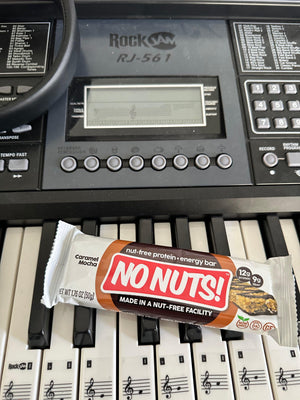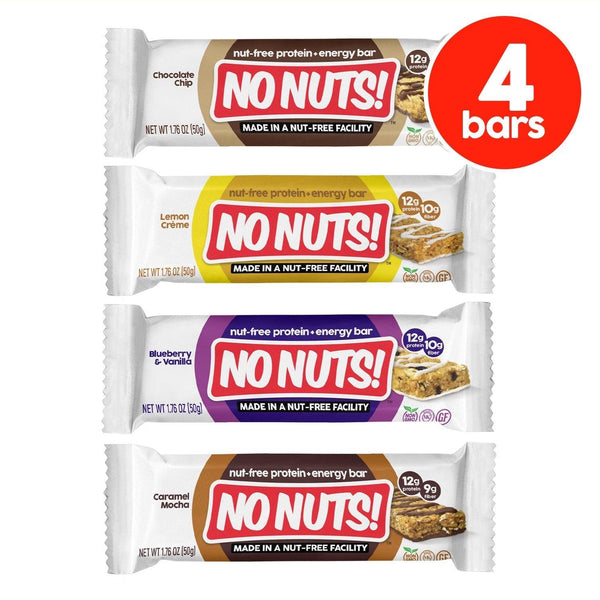Comment créer une classe sans noix : guide de l'enseignant
Nov 13, 2024
Il est très important de créer une salle de classe sûre pour tous les élèves, surtout en ce qui concerne les allergies alimentaires. Les allergies aux noix sont courantes, les enseignants doivent donc savoir comment mettre en place et maintenir une salle de classe sans noix. C'est plus facile que vous ne le pensez ! Ce guide vous montrera tout ce que vous devez savoir pour assurer la sécurité de vos élèves. Examinons les étapes à suivre pour rendre votre salle de classe sans noix et sûre pour que tout le monde puisse y apprendre.
Points clés à retenir : créer une classe sans noix
- Expliquez clairement aux parents la règle sans noix et pourquoi elle est importante
- Installez des panneaux faciles à voir dans la salle de classe
- Proposer des collations sûres et sans noix aux étudiants
- Enseignez aux élèves les allergies aux noix par le biais de conférences, de livres et de jeux
- Planifiez des fêtes et des événements sécuritaires pour tous les élèves
- Soyez prêt à faire face aux urgences avec des plans et des exercices
Comprendre les allergies aux noix
Les allergies aux noix sont très courantes et peuvent être très graves. Environ 1 enfant sur 50 est allergique aux noix, ce qui signifie qu'il y aura probablement au moins un élève allergique à ces substances dans votre classe. C'est pourquoi il est si important d'avoir des règles interdisant les noix dans les écoles.
Lorsqu'une personne allergique aux noix mange ou touche des noix, son corps pense que les protéines des noix sont nocives. Cela peut provoquer différentes réactions, allant des démangeaisons cutanées aux difficultés respiratoires. Dans les cas vraiment graves, cela peut même mettre la vie en danger. C'est pourquoi il est si important d'exclure les noix des salles de classe.
Pour en savoir plus sur les allergies aux noix et sur la façon de protéger les enfants, consultez notre guide sur les allergies aux noix . Il contient de nombreuses informations utiles pour les enseignants et les parents.
Aménagement de votre classe sans noix
Il peut sembler difficile au début de rendre votre classe sans noix, mais c'est en fait assez facile. Voici comment procéder :
1. Parlez aux parents
Il est très important d'informer les parents que votre classe est sans noix. Voici comment procéder :
- Envoyer une lettre ou un courriel à tous les parents au début de l'année scolaire
- Expliquez quels aliments ne sont pas autorisés, y compris tous les types de noix
- Donnez des idées de collations et de déjeuners sans noix
- Dites aux parents ce qu’ils doivent faire si leur enfant est allergique aux noix
- Peut-être organiser une réunion pour répondre aux questions
N'oubliez pas de laisser les parents poser des questions. Plus ils comprendront, plus il sera facile de garantir la sécurité de la classe.
2. Créez des panneaux clairs
Des panneaux aident à rappeler à tout le monde la règle d'interdiction des noix. Voici quelques conseils :
- Créez des panneaux colorés que les enfants remarqueront
- Utilisez des mots simples que tout le monde peut comprendre
- Placez des panneaux près de la porte de la classe, des zones de collation et des tables de déjeuner.
- Essayez de créer des expositions amusantes qui renseignent sur les allergies aux noix
Quelques idées de messages à inscrire sur les panneaux :
- « Notre classe est sans noix et fière de l'être ! Aidez-nous à assurer la sécurité de tous nos amis. »
- « Pas de noix autorisées – nous prenons soin les uns des autres ! »
- « Vérifiez vos collations : les noix ne sont pas les bienvenues ici, mais vous, si ! »
- « Zone sans noix : où chaque élève peut apprendre et jouer en toute sécurité »
3. Préparez des collations sûres
Il est judicieux de proposer des collations sans noix dans votre classe. Voici quelques options savoureuses :
- Barres aux pépites de chocolat sans noix – Elles sont délicieuses et contiennent beaucoup de protéines et de fibres.
- Barres à la crème au citron sans noix – Elles ont une agréable saveur de citron et sont également bonnes pour vous.
- Fruits et légumes frais – Comme des tranches de pomme, des bâtonnets de carottes et des baies.
- Galettes de riz ou craquelins – Assurez-vous qu’ils ne contiennent pas de noix.
- Bâtonnets de fromage – Ils sont généralement sans danger pour les enfants allergiques aux noix.
- Graines – Les graines de tournesol ou de citrouille peuvent être une bonne collation si elles sont autorisées.
- Yaourts – Choisissez-en qui ne contiennent pas de noix.
Vérifiez toujours les étiquettes pour vous assurer que les collations sont vraiment sans noix. Dressez une liste de collations sans danger à partager avec vos parents.
Enseigner aux élèves les allergies aux noix
Il est important d'aider les enfants à comprendre les allergies aux noix. Voici quelques moyens d'y parvenir :
1. Organisez une discussion en classe
Parlez à vos élèves des allergies alimentaires, en particulier des allergies aux noix. Vous pouvez :
- Expliquez les allergies d’une manière que les enfants peuvent comprendre
- Parlez des raisons pour lesquelles certains aliments peuvent être dangereux pour les personnes allergiques
- Dites aux enfants qu’il est important d’être gentil avec leurs camarades de classe allergiques
- Laissez les élèves poser des questions et partager leurs propres histoires
- Entraînez-vous à réagir si quelqu'un a une réaction allergique
Gardez le discours positif et concentrez-vous sur la manière dont chacun peut contribuer à assurer la sécurité de la classe.
2. Lisez des livres sur les allergies
Les livres peuvent aider les enfants à mieux comprendre les allergies. En voici quelques-uns :
- « La princesse et l'allergie aux arachides » de Wendy McClure
- « Les BugaBees : des amis allergiques aux aliments » par Amy Recob
- « Allie l'éléphant allergique : une histoire pour enfants sur les allergies aux arachides » par Nicole Smith
- « Le cornichon aux arachides : une histoire d'allergie aux arachides » par Jessica Ureel
Après la lecture, parlez des histoires et demandez peut-être aux enfants d’inventer leurs propres histoires sur la nécessité d’être gentil avec des amis allergiques.
3. Jouez à des jeux de sensibilisation aux allergies
Les jeux peuvent rendre l’apprentissage des allergies amusant. Essayez ceux-ci :
- « Chasse au trésor des aliments sans danger » : trouvez des images d’aliments sans danger pour une personne allergique aux noix.
- « Allergy Action Match-Up » : associez les symptômes d’allergie à ce qu’il faut faire à leur sujet.
- « Détective des ingrédients » : regardez les étiquettes des aliments pour trouver les allergènes.
- « Bingo de sensibilisation aux allergies » : jouez au bingo avec des informations sur les allergies.
- « Super-héros de la sécurité » : inventez des personnages de super-héros qui protègent les personnes allergiques.
Pour plus d’idées sur la façon d’enseigner aux enfants les allergies aux noix et les collations sûres, consultez notre guide des collations scolaires sans noix pour les enfants .
Gestion des occasions spéciales et des célébrations
Les fêtes et les événements spéciaux peuvent être difficiles à organiser dans une classe sans noix, mais ils peuvent néanmoins être amusants et sûrs. Voici comment :
1. Célébrations non alimentaires
Essayez ces idées amusantes qui n’utilisent pas de nourriture :
- Faites de l'enfant qui fête son anniversaire une aide spéciale pour la journée
- Organisez une soirée dansante avec leurs chansons préférées
- Réalisez ensemble un projet artistique spécial
- Laissez l'enfant qui fête son anniversaire choisir un jeu auquel tout le monde pourra jouer
- Fabriquez un « trône d’anniversaire » sur lequel ils pourront s’asseoir pendant l’heure du conte.
- Créez un « cercle de compliments » où chacun dit de belles choses à propos de l’enfant qui fête son anniversaire
- Laissez-les apporter un livre préféré pour que vous le lisiez à la classe.
2. Options de friandises sécuritaires
Si vous souhaitez manger lors de fêtes, essayez ces options sûres :
- Échantillon sans noix, lot de 4 - Ce coffret contient différentes saveurs sans noix que tout le monde peut apprécier.
- Brochettes de fruits
- Popcorn en petits sachets (vérifiez d'abord les ingrédients)
- Sucettes glacées ou barres de fruits (assurez-vous qu'elles ne contiennent pas de noix)
- Friandises Rice Krispies (utilisez des guimauves et des céréales sans noix)
- Parfaits au yaourt avec fruits et granola sécuritaire
- Plateaux de légumes avec trempettes sans noix
- Mini pizzas avec garniture sans noix
- Smoothies aux fruits et légumes
Vérifiez toujours les ingrédients et préparez vos friandises dans une cuisine sans noix. Discutez avec les parents d'enfants allergiques pour vous assurer que les friandises sont sans danger.
Préparation aux situations d'urgence
Malgré toutes ces précautions, il est important d'être prêt à faire face aux situations d'urgence. Voici ce que vous devez savoir :
1. Connaître les signes d’une réaction allergique
Apprenez à repérer ces symptômes :
- Bosses rouges qui démangent sur la peau
- Gonflement des lèvres, de la langue ou du visage
- Difficulté à respirer ou respiration sifflante
- Maux d'estomac ou vomissements
- Sensation de vertige ou d'évanouissement
- Gorge serrée ou voix rauque
- Tousser beaucoup
- Peau pâle ou bleutée
- Se sentir confus ou très effrayé
Les réactions allergiques peuvent survenir rapidement ou lentement et peuvent être légères ou très graves.
2. Ayez un plan d’urgence
Travaillez avec l'infirmière scolaire et les parents pour élaborer un plan qui comprend :
- Où sont conservés les médicaments d'urgence
- Comment utiliser un auto-injecteur d'épinéphrine
- Numéros de contact d'urgence
- Quand utiliser des médicaments et quand appeler le 911
- Ce que tout le monde devrait faire en cas d’urgence
- Comment le dire au reste de l'école
- Que faire après une réaction
Assurez-vous que tout le monde, y compris les enseignants suppléants, connaisse ce plan.
3. Pratiquez des exercices d'urgence
Entraînez-vous à ce qu’il faut faire en cas d’urgence :
- Effectuez régulièrement des exercices, comme des exercices d'incendie.
- Inclure tout le personnel et les étudiants
- Pratiquez différentes situations, comme des réactions pendant le cours ou le déjeuner
- Entraînez-vous à utiliser des auto-injecteurs d'épinéphrine
- Chronométrez les exercices pour voir à quelle vitesse vous pouvez réagir
- Parlez de ce qui s'est bien passé et de ce qu'il faut améliorer après chaque exercice
- Parfois, demandez à l'infirmière scolaire ou aux intervenants d'urgence de vous aider lors des exercices.
La pratique aide chacun à rester calme et à agir rapidement en cas d’urgence réelle.
Conclusion
Il est très important de créer une classe sans noix pour assurer la sécurité de tous vos élèves. Cela peut sembler difficile au début, mais en suivant ces étapes, vous pouvez créer un endroit où chaque élève se sent en sécurité et peut se concentrer sur son apprentissage. En parlant aux parents, en enseignant à vos élèves et en vous préparant, vous ne créez pas seulement une classe sans noix, vous apprenez aux enfants à prendre soin les uns des autres.
Pour plus d'informations sur les allergies aux noix dans les écoles, consultez notre blog . Vous y trouverez de nombreux articles et conseils.
Si vous avez besoin de collations sans noix pour votre classe, jetez un œil à notre collection de barres énergétiques sans noix . Elles sont savoureuses et sans danger pour tout le monde.
N'oubliez pas que vos efforts pour éviter que des noix ne se retrouvent dans votre classe font une grande différence pour vos élèves. En appliquant ces idées et en vous tenant informé, vous rendez l'école plus sûre et plus accueillante pour tous. Continuez votre excellent travail et passez une excellente année scolaire !









